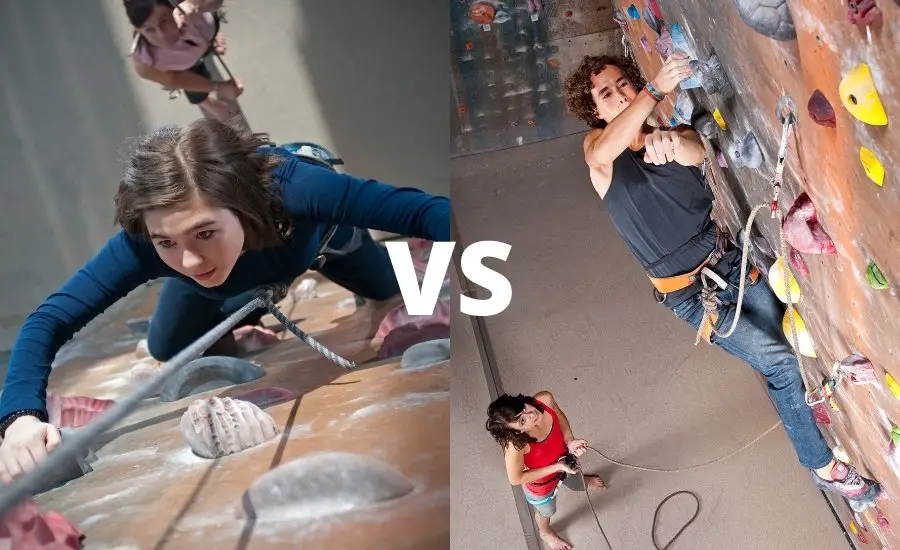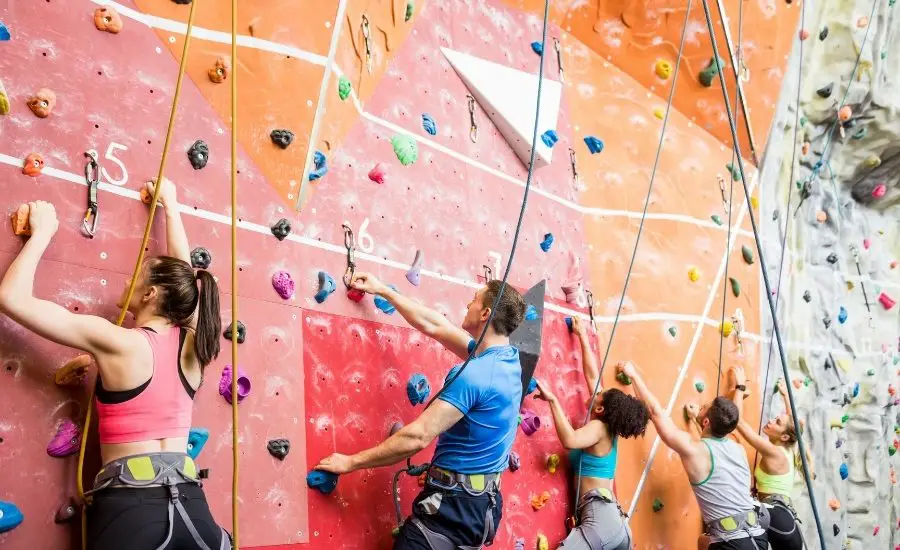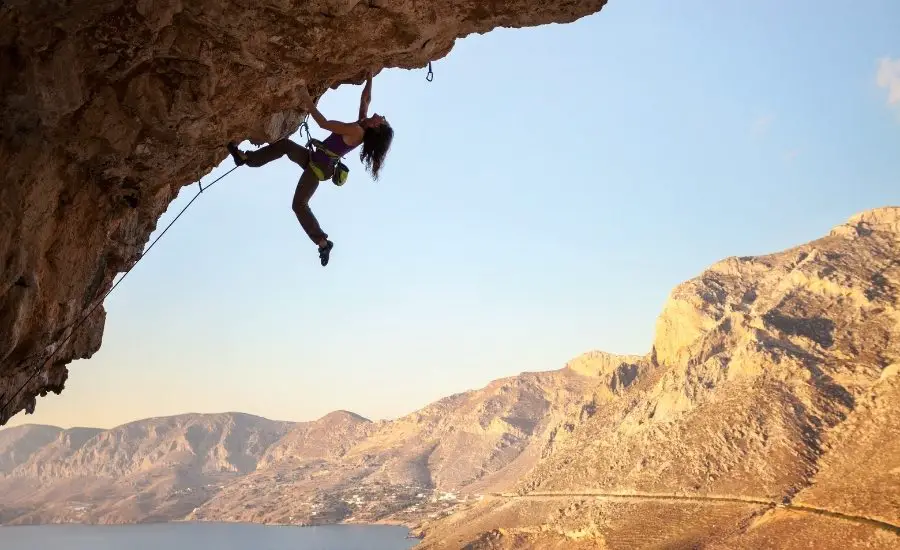Top roping vs lead climbing has been a hot topic in the climbing community for a while now. The majority of climbers will say that lead climbing is clearly harder while a smaller amount are not buying it. I have spent a few hours researching this and hope to help settle this debate.
As a general rule, lead climbing is approximately one-half of a YDS grade harder than top roping. Lead climbing is more physically demanding and requires a greater technical climbing ability. In addition, lead climbing requires climbers to be more mentally prepared than they would be for top roping.
While my statement above applies for the majority of climbers, there are a few circumstances where lead climbing and top roping were found to be about equal. I discuss these circumstances and go into detail as to why lead climbing is harder than top roping for the majority of climbers below.
Difficulty of Lead Climbing vs Top Rope

Before we get too deep into this, we should clarify what we mean by “lead climbing”. Lead climbing includes both sport and trad climbing. It is kind of like the whole square and rectangle thing: all squares are rectangles but not all rectangles are squares. All sport climbs are lead climbs but not all lead climbs are sport climbs. Therefore, this article will touch on both trad and sport climbing.
Naftali Harris conducted a statistical analysis of 28 members of the 2014 Stanford Climbing Team and posted the results of it on his blog linked here. As part of the analysis, the climber’s maximum top rope and lead (sport) grade were compared.
Of the 16 Stanford climbers who sport-climbed as well as top roped, 6 of them (37.5%) climbed 1/2 grade harder while top roping (i.e a climber who top ropes 5.12a would sport climb 5.11c). 11 of the 16 climbers (68.8%) climbed between 1/4 and 3/4 of a grade harder while top roping (i.e. 68.8% of 5.12a top rope climbers would sport climb between 5.11b and 5.12d).
None of the climbers were able to lead climb harder than they could top rope.

I believe that this discrepancy between top rope and sport climbing ability boils down to three factors:
- The increased technical difficulty of lead climbing
- Added mental challenges of lead climbing
- The increased physical exertion needed to clip
It should be noted that not all of the climbers analyzed experienced a decrease in their sport climbing grade from their top rope grade. 3 of the 16 climbers (18.8%) were able to sport climb just as hard as they could top rope. Potential reasons for this are discussed in the mental and physical sections below.
Increased Technical Difficulty
Of the three climbing types (trad, sport, and top rope), trad climbing has the most technical difficulty associated with it. Unlike sport and top rope, trad requires climbers to bring their protection with them and place the gear as they go.
Both trad and sport climbing require climbers to clip their rope into protection as they make their way up the route. Having the correct body position and good climbing technique become vitally important in lead climbing. Being in the proper position and having a solid hold of the wall will allow climbers to clip without exerting too much energy.

In addition to this, climbers need to make sure that they are maintaining proper rope position and are clipping properly. If they are unable to do so, the climber can suffer serious injuries when they take a fall.
Top roping does not require the climber to worry about clipping technique or rope positioning. They just have to worry about working their way up the route. Additionally, making sure you have good body position is more important on sport routes than it is on top rope routes due to the need to clip.
Added Mental Challenges
Lead climbing can be a huge mental challenge for climbers, especially ones that are still inexperienced with it. When taking a fall on lead, the climber can fall up to twice the distance between them and their nearest protection. This is a lot farther than taking a fall on top rope. The increased fall distance can be quite a mental hurdle to jump.
In addition to taking larger falls, climbers may also worry if they clipped properly, how far the next clip is, and when they should make the next clip.

Trad climbing also adds additional mental pressures to those of sport climbing. You have to trust that the protection you are placing is functioning properly, put in the right place, and installed properly. This is a lot to worry about while hanging on the side of a cliff.
A study titled “A psychophysiological comparison of on-sight lead and top rope ascents in advanced rock climbers” was conducted by Simon Fryer and was originally published in the Scandinavian Journal of Medicine and Science in Sports in 2012.
The study compared the physical and mental stress of lead climbing and top roping in 21 advanced rock climbers. Notably, the study stated:
Research suggests that lead climbing is both physiologically and psychologically more stressful than top rope climbing for intermediate performers . . . Findings suggest that advanced rock climbers do not find lead climbing to be more stressful than top rope climbing during an on-sight ascent.
It seems that advanced lead climbers do not experience the same degree of mental challenges as less experienced lead climbers because they are accustomed to the mental challenges lead climbing presents. This could be a factor as to why some of the Stanford climbers’ climbing ability did not drop while sport climbing and others did.
Increased Physical Difficulty
The increased physical difficulty stems from the need to clip (and place protection in the case of trad climbing). Clipping requires climbers to take one of their hands off the route. The longer it takes a climber to clip, the more energy the climber will have to expend.

This energy expenditure will take a toll on the climber’s muscular endurance and will cause them to climb lower grades on lead than on top rope. This energy expenditure can be mitigated by having proper body position, good clipping technique, and knowing the best time to clip.
The same study referenced in the above section found that the advanced climbers did not experience added physical stress while lead climbing compared to top roping. Notably it stated “No significant differences were found between conditions for VO2 or blood lactate concentration.”
This indicates that top roping and lead climbing were found to be approximately the same difficulty for advanced climbers. It is likely that the advanced climbers have better climbing technique and body positioning than less skilled climbers and are therefore able to spend less time and energy clipping. This allows them to climb just as hard top roping as it does lead climbing.
The Bottom Line
Lead climbing is technically, mentally, and physically harder than top roping for most climbers. Advanced climbers who are very experienced in lead climbing will experience less psychological and physical stress while lead climbing than more inexperienced lead climbers.
